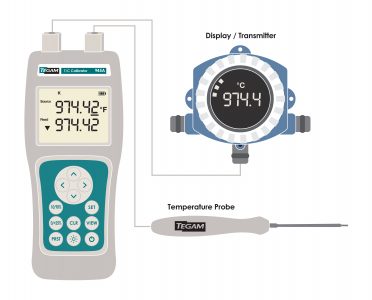How to Use Thermocouple Temperature Calibrators as a Circuit Diagnostic Tool
Veröffentlicht Januar 13, 2020 von Advanced Energy Editor

Did you know that you can use your thermocouple temperature calibrator as a diagnostic tool to troubleshoot your temperature control circuit?
To maximize your thermocouple temperature calibrator as a diagnostic tool, it must have a combination of key features. It needs a dual display – one showing the value of the output signal and a second display to show the value of the input signal; SOURCE and MEASURE functions.
The thermocouple temperature calibrator also needs the output (SOURCE) and input (MEASURE) channels to be independent functions so that the temperature calibrator can simultaneously SOURCE and MEASURE in your circuit.
Simultaneous SOURCE and MEASURE with the Temperature Calibrator
With the two independent displays and independent input and output channels, good temperature calibrators can simultaneously SOURCE a highly accurate thermocouple signal to a controller and simultaneously MEASURE the output of a thermocouple in the process to verify that the controller, the connecting circuits, and the heat source are working properly. You can READ the value of the signal going to the controller and the simultaneous MEASURE function allows you to monitor the system response and validate that your system stabilizes at the proper temperature. You can also watch the displays to see if the system undershoots or overshoots the set point.
Transfer Mode
When troubleshooting a system with a thermocouple transmitter in-line with the controller, you can use the Transfer Mode to verify the system end to end – the transmitter, the system thermocouple and the signal cabling.
Using Transfer Mode in a System with a Transmitter:
Select Transfer mode. Then connect the system’s thermocouple to the input of the temperature controller and connect the output channel of the temperature calibrator back to the input of the transmitter. The temperature controller will MEASURE the System Thermocouple connected to its input and automatically re-transmit an isolated voltage equal to the exact value of the input from the thermocouple to the transmitter. This allows you to validate the thermocouple reading and to create a valid isolated signal input to the transmitter – eliminating ground loops and electrostatic noise, as well as being able to view open or intermittent circuit connections. The retransmitted signal is displayed on the SOURCE display. This validates the signal going to the transmitter. You should quickly be able to determine if there is a problem with the transmitter by reading the upstream instrument or verify the controller setting by reading the thermocouple signal you are re-transmitting. The Transfer Mode gives you an end-to-end system check with a system including a transmitter.
Using Transfer Mode in a System without a Transmitter:
The Transfer Mode is just as valuable in a thermocouple circuit without a transmitter. Connect the thermocouple into the input (READ) channel and the downstream instrument into the SOURCE channel and you can watch how your system performs. You get the same isolation, and you can read the temperature from the thermocouple. This allows you to validate that this is the signal being sent to the meter or downstream control circuit. This is a quick and easy way to validate that the wiring and sensing circuit is working properly.
Only the Advanced Energy's TEGAM 940 thermocouple temperature calibrators and 945 thermocouple temperature calibrators have the combination of the isolated Transfer Function and dual displays to simultaneously display SOURCE and MEASURE values. See more information and purchase these innovative and rugged devices by visiting our Temperature Calibrator section of our website.
Please contact us if you have any further questions regarding our temperature calibrators, digital thermometers or other Test & Measurement instruments. Thanks for reading!
Advanced Energy Editor
Advanced Energy
durchsuchen
Kategorien A-Z
Tragen Sie sich in unsere Mailingliste ein
Abonnieren
Neueste Beiträge
View on X
